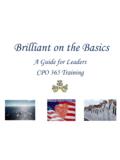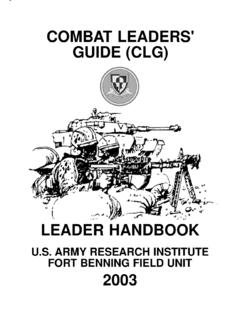Transcription of School Turnaround Leaders - Public Impact
1 School Turnaround Leaders :Part of the School Turnaround Collection from Public ImpactFor The Chicago Public Education Fund, June 2008 2008 Public Impact for The Chicago Public Education FundAll competencies from Competence at Work, Spencer and Spencer (1993). Acknowledgements This report was funded by The Chicago Public Education Fund. In particular, the authors would like to thank Kathleen St. Louis for her support and guidance. The authors would also like to thank Alan Anderson, Director, Office of School Turnaround , Chicago Public Schools; Brian Sims, Managing Director, Academy of Urban School Leadership; and Melissa DeBartolo, Leadership Recruitment and Talent Management, Chicago Public Schools for their comments on this work. About the Authors The guide was prepared by Public Impact , a national education policy and management consulting firm based in Chapel Hill, North Carolina. Contributors from Public Impact include Lucy M. Steiner, Emily Ayscue Hassel and Bryan Hassel.
2 Graphic design by Tripp Tuttle, Quip Creative. Table of Contents Making the Most of This Guide: What You Need to Know .. 3 About this Guide .. 3 Using Competencies and Actions for School Turnaround Leader Success .. 4 Turnaround Leader Actions: Consistent Cross-Sector Findings .. 5 Turnaround Leader Competencies with Competency Levels .. 7 Turnaround Leader Competencies: Four Clusters of Competence .. 8 Turnaround Leader Competency List and Definitions .. 9 Driving for Results Cluster .. 10 Achievement .. 11 Initiative and Persistence .. 13 Monitoring and Directiveness .. 15 Planning Ahead .. 17 Influencing for Results Cluster .. 19 Impact and Influence .. 20 Team Leadership .. 22 Developing Others .. 24 Problem Solving Cluster .. 26 Analytical Thinking .. 27 Conceptual Thinking .. 29 Showing Confidence to Lead .. 31 Self-Confidence .. 32 What Competencies Support Turnaround Leader Actions? .. 34 Page 2 of 35 Making the Most of This Guide: What You Need to Know About this Guide Why are Leaders So Important in a Turnaround ?
3 Evidence collected over the last 30 years suggests that effective School Leaders significantly influence student learning and other aspects of School Documented experience also indicates that individual Leaders in failing organizations in various sectors, including education, can effect rapid, dramatic School Turnaround is possible, but it takes a broader, concerted effort with daring leadership at the helm and persistent, achievement-oriented collaboration among staff. That is the stuff of which rapid, bad-to-great turnarounds across sectors are made. This guide aims to help districts attempting turnarounds understand the underlying characteristics of Leaders likely to succeed in this unique context, based on the best available research to date. As more schools attempt turnarounds , increasingly accurate, detailed descriptions of Leaders who are successful in this context will be possible. What Does This Guide Include? This is a companion guide to several other documents related to selecting Leaders and teachers for Turnaround schools.
4 All of these guides seek to clarify the most critical competencies or patterns of thinking, feeling, speaking and acting that enable people to be successful in attempts to transform schools from failure to excellence quickly and dramatically. This guide provides leader competency definitions, School examples, and detailed levels of increasingly effective competence. For more specific information about how to select School Leaders for Turnaround schools, see Leaders for School turnarounds : Selection Toolkit. For information about teacher competencies and teacher selection in Turnaround schools, see Teachers for School turnarounds : Competencies for Success and Teachers for School turnarounds : Selection Toolkit. With the right tools and processes, competencies are strong predictors of work performance and can be very effective guideposts for selection, professional development, promotion, outplacement and pay. Page 3 of 35 1 Leithwood, K.
5 , Louis, , Anderson, S., & Wahlstrom, K. (2004). How leadership influences student learning. Minneapolis: University of Minnesota; Leithwood, K. & Riehl, C. (2003). What we know about successful School leadership. Philadelphia, PA: Laboratory for Student Success, Temple University; Waters, , Marzano, , & McNulty, (2003) Balanced leadership: What 30 years of research tells us about the effect of leadership on student achievement. Aurora, CO: Mid-continental Research for Education and Learning; Davis, S., Darling-Hammond, L., LaPointe, M., & Meyerson, D. (2005). School leadership study: Developing successful principals. Stanford, CA: Stanford Educational Leadership Institute. 2 See School turnarounds : A Review of the Cross-Sector Evidence on Dramatic Organization Improvement, by Public Impact for the Center on Innovation and Improvement (2007) and turnarounds with New Leaders and Staff by Kowal and Hassel of Public Impact for the Center for Comprehensive School Reform and Improvement (2006).
6 Using Competencies and Actions for School Turnaround Leader Success What is a Competency ? A competency is a pattern of thinking, feeling, acting or speaking that causes a person to be successful in a job or Competencies may be developed, but they are most powerful when used to select people who are already a good fit for the job. The competencies included here stem primarily from in-depth studies of highly successful Leaders in analogous leadership roles ( , entrepreneurs, managers in complex organizations). These studies quantify the competency differences between typical and highly successful people in these roles. The specific competencies used here were selected to match the Turnaround actions found in cross-sector literature. When more failing schools have turned around, quantitative studies comparing successful and less successful School Turnaround Leaders will be possible and will provide rich examples and precisely targeted competence levels specific to School Turnaround leader success.
7 How is a Competency Different from Actions that Lead to Success in a Job? Actions included in this set of materials about Turnaround Leaders are those that appear consistently in a large body of cross-sector literature about successful bad-to-great Some competencies include patterns of action. Thus, there is some overlap between the competencies and Turnaround leader actions provided here. But other competencies are patterns of thinking and feeling that lead to effective action. What is the Benefit of Using Competencies for Selection? Unlike in the stock market, the future performance of people can be predicted with some accuracy based on past behaviors. Ideally, School districts and School management organizations could choose people who have been successful previously in the same job: Leaders who have already led very successful School turnarounds . But the Turnaround strategy has not been a prevalent approach in education. Furthermore, the large number of schools nationally in which too many students are failing to learn enough demands a large supply of Turnaround Leaders .
8 The competencies included here are phrased to be general enough that they can be used to select Leaders who have shown the right combination of competencies in other jobs, but who have not yet turned around a School . Why is the Combination of Actions and Competencies So Powerful? The actions list will help people selected for Turnaround leader jobs understand what others have done to achieve turnarounds across sectors. The competencies will help with selecting Leaders who may not yet have turned around a School . The competencies also will help Leaders understand and address their personal strengths and weaknesses that may affect success as they embark on the Turnaround challenge. Page 4 of 35 3 The competency-related definitions and major underlying competency research used here come from the ideas of David McClelland and related research documented in Competence at Work, Models for Superior Performance, Spencer and Spencer, 1993 (John Wiley and Sons).
9 4 See School turnarounds : A Review of the Cross-Sector Evidence on Dramatic Organization Improvement, by Public Impact for the Center on Innovation and Improvement (2007) and turnarounds with New Leaders and Staff by Kowal and Hassel of Public Impact for the Center for Comprehensive School Reform and Improvement (2006). Turnaround Leader Actions: Consistent Cross-Sector Findings The actions listed in this section are those found consistently in cross-sector studies of turnarounds , or successful bad-to-great This research documented and analyzed cases in which Public and private organizations that were failing by many measures made very rapid, dramatic performance improvements. (This stands in contrast both to slower, incremental improvements in already strong organizations and to closure followed by starting fresh entirely.) In nearly all cases, these Leaders identify and focus on a few early wins with big payoffs, and they use that early success to gain momentum.
10 These new tactics often break organization norms or rules. The actions occur in a fast cycle of trying new tactics, discarding failed tactics and doing more of what works. Most Turnaround efforts fail, because they are tried in very challenging situations. Repeated attempts with a new leader, for example may be critical to Turnaround success in a large portion of schools. The Most Important Turnaround Actions Fortunately, the steps toward Turnaround success are very consistent across sectors. The complete list of critical actions appears on the following page. But School Leaders trying turnarounds must stay focused on accomplishing the most critical, consistent success actions. In nearly all cases, Leaders of successful turnarounds : 5 Identify and focus on a few early wins with big payoffs, and use that early success to gain momentum. While these wins are limited in scope, they are high-priority, not peripheral, elements of organization performance.






